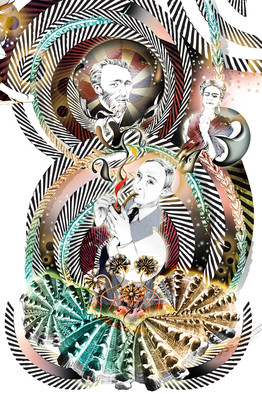Serendip is an independent site partnering with faculty at multiple colleges and universities around the world. Happy exploring!
Mental Illness & Creativity?

"The Chinese believe that before you can conquer a beast you first must make it beautiful" (5).
--Kay Redfield Jamison, An Unquiet Mind
My friend recently sent me an article written by Jeanette Winterson (one of my favorite authors!) from the Wall Street Journal entitled "In Praise of the Crack-Up: A novelist peers through darkness to find glittering gems in writing and art". Winterson divulges a description of her own battle with depression and how her illness provided her with a creative outlet and "gave [her] life meaning and shape."

I've always been interested in this cliche of "the tortured artist". How does creativity emerge from the disabled mind? Is it the illness itself that gives rise to creativity, or is it the suffering and anguish that comes with illness that births an innovative artistry? When I attended a disability studies reading group at Haverford in preparation for the "in/visible: Disability and the Arts" conference, someone mentioned that it's dangerous to talk about illness as inspiring or somehow productive because it fails to illuminate the pain and despair that come with disability. There's also a movement going on in queer studies right now that encourages individuals to embrace feelings of dejection. Heather Love, in her book Feeling Backward: Loss and the Politics of Queer History, explains, "Texts that insist on social negativity....describe what it is like to bear a 'disqualified' identity, which at times can simply mean living with injury--not fixing it" (4). Disability studies advocates a similar stance. It positions itself against efforts to "cure" and notions of "fixing." The introduction to Snyder's Disability Studies: Enabling the Humanities claims that culture has a "fragile tolerance for discomfort; pain is to be avoided, illness to be cured, and disability to be corrected or concealed" (2). But for those who live on the margins--those who are "queer" in the widest sense (mental illness included)--perhaps the only means of finding peace is by considering the "beauty" in their own oppression, or as Jamison says, by making "the beast", or illness, beautiful.
Winterson, like Love, tells us that creativity comes with a cost. She tells us that it is only by relishing the festering wounds of mental disabilities that imagination and artistry emerge. After quoting a poem by Percy Bysshe Shelly, which alluded to his own melancholia and madness, Jamison writes in Touched by Fire (a book that explores the connections between creativity and manic-depressive illness), “That such a final, tragic, and awful thing as suicide can exist in the midst of remarkable beauty is one of the vastle contradictory and paradoxical aspects of life and art” (46). And it is in this opposition between darkness and beauty, this tension between what Jamison considers polarized forces, that creativity is birthed, becomes generative, and fosters expression via multiple artistic forms.
For Winterson, art is not fiction, but truth. She writes, “Taking the mundane or the weighted, the overlooked or the too familiar, art is able to re-show us ourselves and ourselves in the world. Art holding up a mirror to life is commonly misunderstood as realism, but in fact it is recognition. We see through our own fakes, our own cover stories, we see things as they are, instead of how they look, or how we’d like them to be.” For Winterson, art (writing, in particular) becomes a device that can puncture, that allows for a cracking open of traits, behaviors, and ways of thinking that we struggle to contain through the creation and reinforcement of categories such as "sane" and "insane", "normal" and "crazy", and prompts a leaky release. She writes, "Art isn't a surface activity. It comes from a place and meets the wound we each carry." But she also acknowledges that those with mental disabilities may never actually reach their wounds, that they may never find their own "loss", that they may never quite puncture themselves beyond their own flesh. They feel the presence of their illness and through time may learn to understand the ways their own disabilities operate, but the sickness remains lodged inside; it can't be located.
But is this effort to find one's illness therapeutic? If therapy is often about embracing one's fears and overcoming the avoidances that come with those fears, then art potentially allows for a communion with one's deepest horrors. The creator of art, she tells us, experiences exposure and that there exists no medium to mediate his or her own fears; the artist remains unbuffered, unprotected. But for those merely experiencing the work of others, she writes, "Art mediates the encounter, allowing us to get nearer to our longing and our loss, to risk more, to dare more." How does this mediation become problematic? Does it reinforce the borders and boundaries that lie between "health" and "illness"? I think, too, that culture tries to mediate mentally ill artists. In her article, Winterson references Emily Dickinson, Virginia Woolf, and Sylvia Plath--three iconic women writers that were believed to have suffered from mental illnesses. We have a tendency to read Woolf and Plath through their suicides and Dickinson through her reclusion. And what might their fame have to do with their disabilities? To become an icon, or acquire fame, must one be deemed infamous, bearing the wounds of his or her own stigmatization for the purpose of public consumption and the often injurious gaze that comes with spectacle or performance?


